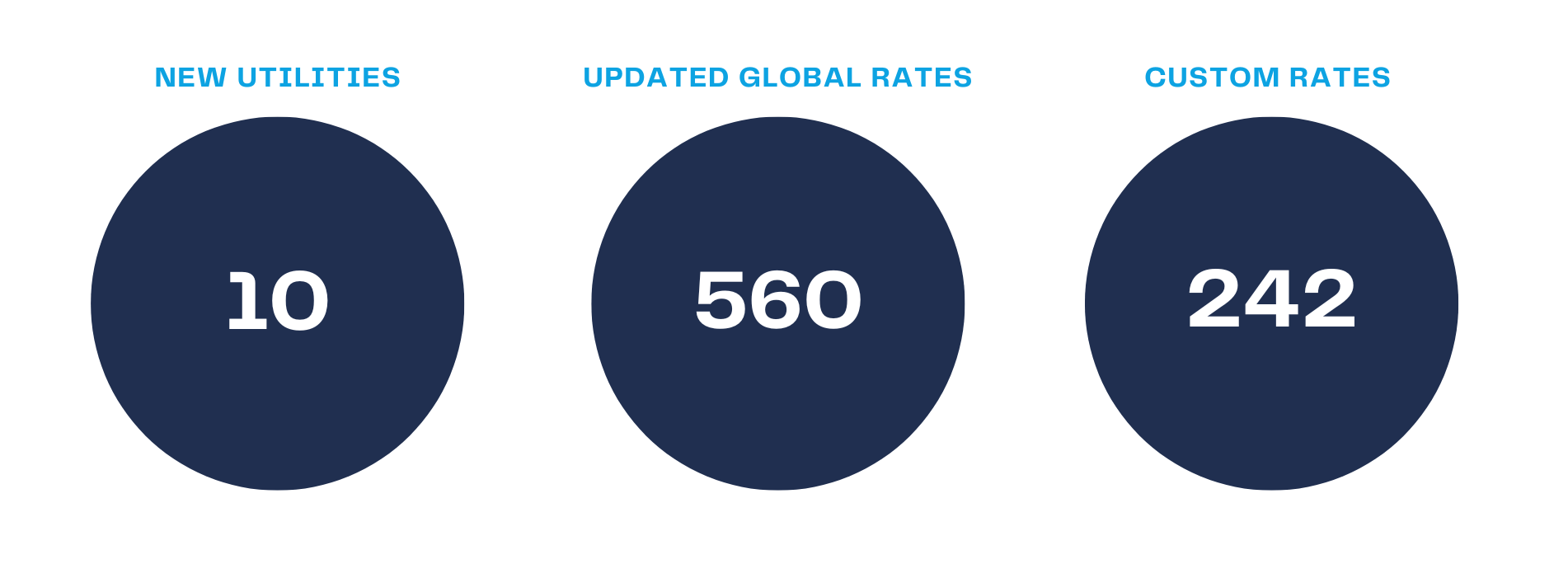July 2022 Utility Rates Newsletter
by Sarah Wood on Jul 28, 2022
ETB Developer
utility rates
utility rate updates
Here's what our team added in the last month:
Now totaling 85 Wisconsin-based electric companies in ETB Developer.
IMPORTANT MONTHLY UPDATES & ANNOUNCEMENTS
It is not uncommon for electric utilities to implement changes midyear. In this month’s newsletter, we summarize a significant bill increase many Illinois electric customers will experience, highlight a recent base rate increase approval affecting two of our more heavily used Northeastern utilities, provide insight on a weather-related international rate change, and answer a frequently asked question from our users regarding the availability of rates within our ETB Developer database.
Ameren Illinois BGS Update
Ameren Illinois recently updated its Basic Generation Service (BGS) charges for the summer and non-summer seasons. This is the most common type of service that Ameren customers receive when they are not contracted with a third-party supplier. When comparing the summer of 2021 to this summer, the BGS charges for the residential DS-1 rate went from $0.03375/kWh to $0.08765/kWh, respectively. This is an increase of 160% and an additional $54 for every 1,000-kWh consumed! Pair that with unprecedented heat waves and the drastic increases in the costs required to generate energy, and the potential for exceptionally high electric bills this year is highly likely for Illinois residents.
The BGS prices for the coming winter offer no relief. Ameren’s non-summer BGS rates for DS-1 customers saw a notable increase, increasing from $0.03956/kWh to $0.10867/kWh for the first 800kWh, and from $0.03758/kWh to $0.08443/kWh for everything over 800kWh. There have been comparable price increases for other Ameren Illinois rates like DS-2, DS-4, and DS-5, which include commercial customers. Our rates team creates rates using the most recent charges available from the utility, as this most accurately reflects what customers will pay for in the coming months or year ahead. Utilizing these increased charges means that discrepancies when comparing bill totals in ETB Developer to older Ameren bills are likely. If discrepancies are identified, our rates team is always willing to ensure that the differences seen are in fact caused by the changes in the utility’s charges rather than other influential factors.
Orange & Rockland Base Rate Update
A long-anticipated base rate update finally went into effect for the Orange & Rockland Utilities (ORU), which spans the states of New York and New Jersey. ORU proposed a net increase in delivery revenue of 2.9 million dollars – an overall 5.8% increase across all rate classes. The additional delivery revenue increase will raise the monthly bill by 7.5% for a residential customer using 600 kWh per month. Considering other charge changes, the total residential bill increase is projected to be around 4.9%.
After multiple delays, a joint proposal was agreed upon that will initiate planning for a gradual rate increase annually for the next three years. Much of the revenue generated by these increases will cover infrastructure costs, depreciation on plant additions, recover reduced sales, and offset increases in labor costs. Some revenue will be allocated to grid modernization, providing strategic underground improvements, and vegetation management for storm hardening and protection.
While these increases have materialized when prices are at an all-time high, ORU has worked proactively to mitigate some of the effects of these increases by implementing a wage freeze for senior management for 27 months. In addition, ORU is passing along COVID-19 relief-related payroll tax credits spread over the three-year rate plan period to reduce the bill impact.
Did you know? - Rates in Costa Rica were reduced due to the start of the rainy season.
From July to September 2022, electricity consumers in Costa Rica will see a decrease in electric rates of approximately –0.62% to –9.92% depending on the utility. Per ARESEP, the regulatory authority, the reduction is caused by a decrease in the variable cost of generation. This current quarter is defined as a rainy season, which interestingly means that Costa Rica is not generating energy using fuels but is relying on hydroelectric plants to produce electricity instead. Similar reductions in costs were seen in Q3 of 2020 and 2021, where the increase in the production of electricity using hydroelectric sources directly resulted in lower rates. Below is a list of the Costa Rica utilities available in our ETB Developer, along with the percentage decrease applicable to all rate schedules.
FAQ: Why is the rate I need not already available in the database?
We often describe ETB Developer as a user-driven platform because it very much so is! Our platform contains nearly 2,000 utilities and tens of thousands of custom and global rates. Custom rates are created per request based on provided bills and tend to involve charges or programs specific to that individual customer. Our global rates are available to all ETB users and contain the default standard charges applicable to all retail customers receiving service from that utility. We currently have over 85,000 global rates available in our database, and each one of these rates was created because an ETB user needed it. If the desired rate is not present in our database, you are either the first user to request that rate, or the rate must be created as custom. All requests and rate-related questions can be sent directly to our team atutilityraterequest@energytoolbase.com; we are always happy to help!


